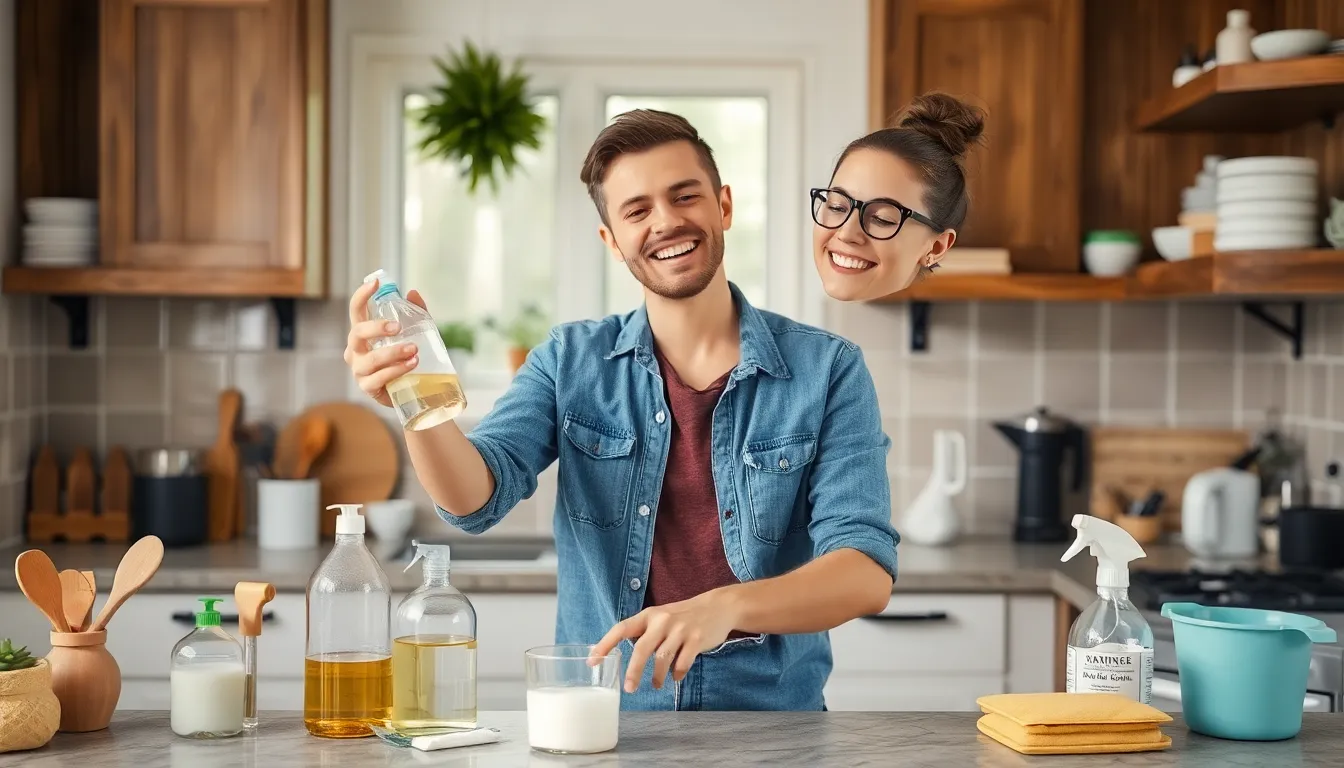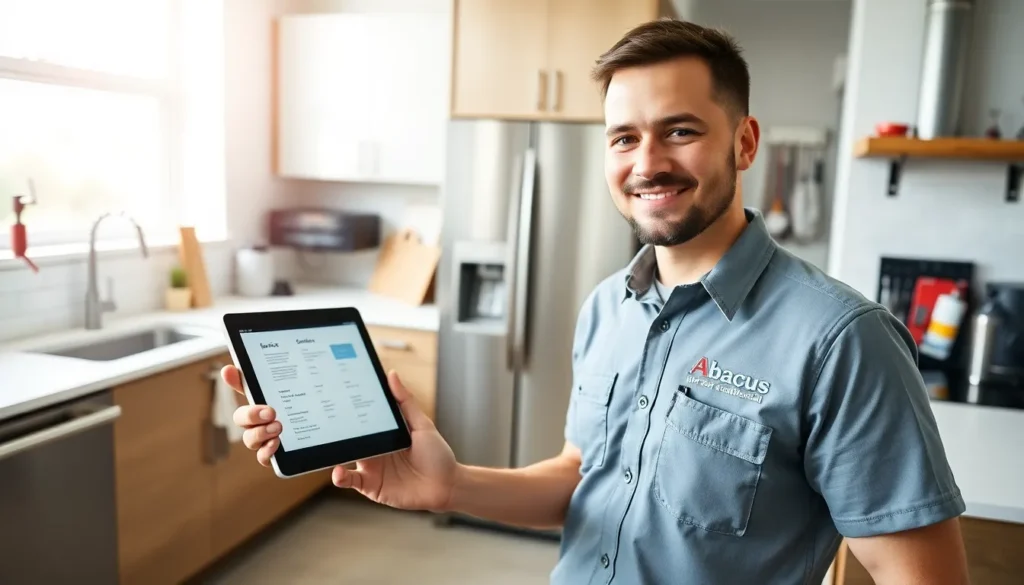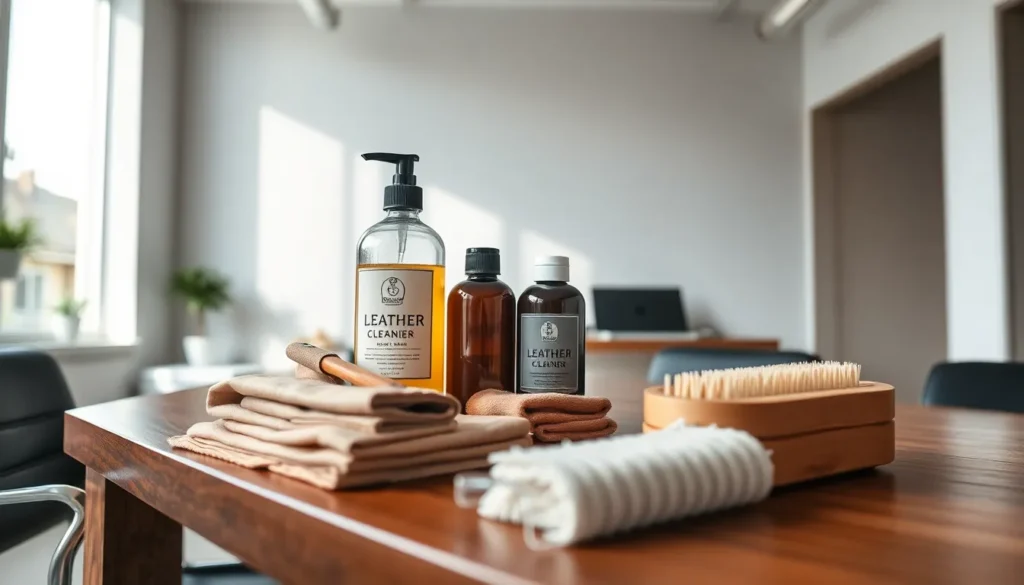In a world where cleaning products seem to multiply like rabbits, DIY cleaning has become the superhero we didn’t know we needed. Why spend a fortune on fancy bottles filled with mystery liquids when you can whip up your own concoctions from ingredients already lurking in your pantry? It’s like cooking, but instead of a delicious meal, you get a sparkling clean home—and who doesn’t love that?
Table of Contents
ToggleWhat Is DIY Cleaning?
DIY cleaning refers to the practice of creating homemade cleaning solutions instead of using commercial products. Individuals often use common pantry ingredients like vinegar, baking soda, and lemon juice. These natural components work effectively in eliminating dirt, stains, and odors.
Many people appreciate the customization options that DIY cleaning offers. Specific solutions can target particular cleaning challenges, such as removing grease or tackling hard water stains. The use of homemade cleaners also minimizes exposure to harsh chemicals, benefiting both health and the environment.
Cost-effectiveness ranks high among the advantages of DIY cleaning. Purchasing a few basic ingredients often results in savings compared to buying multiple commercially available cleaners. With some recipes allowing for large batches, the affordability increases for regular use.
Effectiveness and efficiency also characterize DIY cleaning methods. Each solution often matches or exceeds the performance of commercial products. Users can find a variety of recipes online tailored to various cleaning tasks.
Environmental consciousness plays a significant role in the popularity of DIY cleaning. Many formulations are biodegradable and reduce the amount of plastic waste associated with single-use cleaning products. DIY cleaning aligns with sustainable living practices, attracting eco-friendly individuals.
Overall, DIY cleaning serves as a practical and beneficial approach to maintaining one’s living space. Individuals build a cleaner home while embracing creativity and responsibility in their cleaning routines.
Benefits of DIY Cleaning

DIY cleaning offers several advantages, including cost savings and environmentally friendly practices. Choosing to create homemade cleaning solutions leads to multiple benefits.
Cost-Effectiveness
Cost-effectiveness stands out as a primary benefit of DIY cleaning. Individuals often save significant amounts of money by using basic ingredients from their pantry, such as vinegar and baking soda. Commercial cleaners can be expensive, with prices often exceeding ten dollars each for specialized formulations. In contrast, forming a versatile cleaning supply involves selecting a handful of affordable components. This approach allows homeowners to craft targeted solutions tailored to their cleaning needs. Savings accumulate as they opt for these homemade alternatives, leading to financial relief over time.
Eco-Friendly Options
Eco-friendly options present another key advantage of DIY cleaning. Homemade cleaners typically consist of natural ingredients that reduce reliance on harsh chemicals. Many common household materials possess biodegradable properties, minimizing harmful environmental impacts. For example, vinegar serves as an effective disinfectant without contributing to chemical waste. Baking soda neutralizes odors without releasing toxic fumes. By making these conscious choices, individuals promote sustainability and foster healthier living spaces. Embracing DIY cleaning not only supports personal well-being but also aligns with broader environmental goals.
Essential DIY Cleaning Supplies
DIY cleaning relies on simple ingredients and tools found at home. Specific supplies streamline the cleaning process while ensuring effectiveness.
Common Ingredients
Vinegar serves as a versatile cleaner, effective in cutting through grease and eliminating odors. Baking soda contributes to freshening surfaces and scrubbing away tough stains. Lemon juice acts as a natural disinfectant with pleasant fragrance. Castile soap provides a great option for general cleaning, offering biodegradability without harsh chemicals. Essential oils, such as lavender or tea tree, enhance solutions with additional antibacterial properties and pleasant scents. Cornstarch assists with cleaning windows and polishing furniture. Together, these ingredients create effective, eco-friendly cleaning solutions for various tasks.
Tools You Might Need
Microfiber cloths excel at trapping dust and dirt, ensuring a streak-free shine on surfaces. Spray bottles help with easy application of homemade cleaning solutions. A vacuum cleaner or broom is essential for maintaining floors and removing debris effectively. Scrub brushes and sponges tackle stubborn grime and stains on different surfaces. A mop keeps hard floors clean by removing spills and dirt. Lastly, a measuring cup provides accuracy when mixing ingredients for optimal cleaning results. Each tool enhances DIY cleaning efforts and makes the process more efficient.
Popular DIY Cleaning Recipes
DIY cleaning recipes enhance home cleanliness using simple, natural ingredients. These formulations tackle various cleaning tasks efficiently and sustainably.
Multi-Surface Cleaner
A potent multi-surface cleaner combines equal parts water and white vinegar in a spray bottle. This mixture removes grime on countertops, tables, and appliances without leaving harsh residues. For added fragrance and antimicrobial properties, adding 5 to 10 drops of essential oils like tea tree or lemon works well. Shake the bottle before each use to maintain efficacy and ensure a fresh scent.
Glass Cleaner
To create an effective glass cleaner, mix 1 cup of water with 1 cup of white vinegar. This solution eschews ammonia, making it safe for indoor use. A microfiber cloth proves ideal for spreading the solution across windows and mirrors, leaving them streak-free. For an extra shine, a quick buff with newspaper can enhance clarity after cleaning.
Carpet Stain Remover
Crafting a carpet stain remover requires combining 1 tablespoon of dish soap with 1 tablespoon of white vinegar and 2 cups of warm water. This effective paste addresses tough stains from coffee and wine with ease. Applying it gently with a clean cloth absorbs the stain without damaging carpet fibers. Rinsing the area with cold water and blotting dry ensures complete removal of residue, maintaining carpet integrity.
Tips for Effective DIY Cleaning
Prioritize safety by wearing gloves and masks when making or using cleaning solutions. Consider using a small test area for new mixtures before applying them to larger surfaces. Store all homemade cleaners in clearly labeled containers to ensure proper identification.
Use a measuring cup for accuracy when mixing ingredients. For best results, follow the recommended ratios in popular DIY cleaning recipes. Start with common items such as vinegar, baking soda, and lemon juice, which provide versatility in cleaning.
Incorporate essential oils for added fragrance and antibacterial properties. Essential oils like tea tree and lavender not only enhance scent but also enhance cleaning effectiveness. Choose eco-friendly alternatives that reduce the use of harsh chemicals.
Maintain proper ventilation during cleaning sessions. Keeping windows open allows fresh air to circulate, making the cleaning process safer and more pleasant. Clean from top to bottom in each room, ensuring dust and grime fall toward the floor for easy cleanup.
Always test surfaces for compatibility with homemade solutions. Some surfaces may react differently to natural ingredients, which could lead to damage. Focus on one cleaning area at a time to increase efficiency and maintain organization.
Evaluate the effectiveness of different recipes. Track which solutions work best for specific tasks, adjusting as necessary. Embrace the creativity that DIY cleaning offers, allowing for personalization in cleaning routines.
Use microfiber cloths for optimal results, as they trap dust and dirt more effectively than conventional cloths. Avoid using too much water on surfaces, which can create additional scrubbing challenges later. Rinse tools thoroughly after use to maintain their condition and effectiveness for future cleaning sessions.
Embracing DIY cleaning not only transforms cleaning routines but also promotes a healthier home environment. By utilizing simple ingredients like vinegar and baking soda individuals can tackle various cleaning tasks while minimizing their carbon footprint.
This hands-on approach allows for creativity and personalization in crafting effective solutions tailored to specific needs. With the right supplies and a few safety measures anyone can enjoy the satisfaction of a clean space without the drawbacks of commercial products.
Choosing DIY cleaning is a step toward sustainability and cost savings making it an appealing choice for those looking to enhance their cleaning practices.









